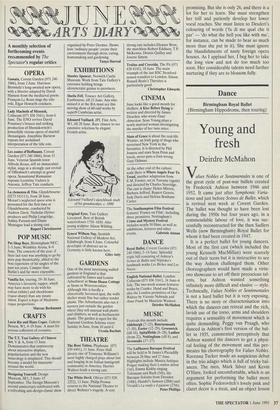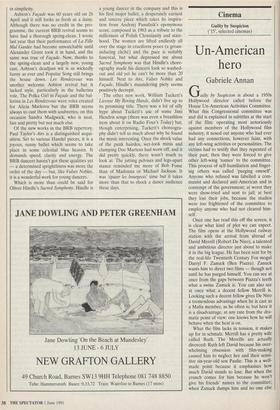Dance
Birmingham Royal Ballet (Birmingham Hippodrome, then touring)
Young and fresh
Deirdre McMahon
Valses Nobles et Sentimentales is one of the great cycle of post-war ballets created by Frederick Ashton between 1946 and 1952. It came just after Symphonic Varia- tions and just before Scenes de Ballet, which is revived next week at Covent Garden. The ballet was thought to have been lost during the 1950s but four years ago, in a commendable labour of love, it was suc- cessfully reconstructed for the then Sadlers Wells (now Birmingham) Royal Ballet for whom it had been created in 1947.
It is a perfect ballet for young dancers. Most of the first cast (which included the young Kenneth MacMillan) were scarcely out of their teens but it is instructive to see the way Ashton challenged them. Other choreographers would have made a virtu- oso showcase to set off their precocious tal- ents, but Ashton wanted something infinitely more difficult and elusive — style. Technically, Valses Nobles et Sentimentales is not a hard ballet but it is very exposing. There is no story or characterisation into which the dancers can retreat and the rich, lavish use of the torso, arms and shoulders requires a sensuality of movement which is quite demanding. Peggy van Praagh, who danced in Ashton's first version of the bal- let in 1935, commented perceptively that Ashton wanted the dancers to get a physi- cal feeling of the movement and this per- meates his choreography for Valses Nobles. Ravenna Tucker made an auspicious debut in the trio adagio which is full of tricky bal- ances. The men, Mark Silver and Kevin O'Hare, looked uncomfortable, which is an argument for performing the ballet more often. Sophie Fedorovitch's lovely pink and claret decor is a treat, and an object lesson in simplicity.
Ashton's Façade was 60 years old on 26 April and it still looks as fresh as a daisy. Although there was no credit in the pro- gramme, the current BRB revival seems to have had a thorough spring-clean. I wrote last year that their performance of La Filk Mal Gardee had become unwatchable until Alexander Grant took it in hand, and the same was true of Façade. Now, thanks to the spring-clean and a largely new, young cast, Ashton's deadpan wit is as wickedly funny as ever and Popular Song still brings the house down. Les Rendezvous was another welcome Ashton revival but it lacked style, particularly in the ballerina role. The Polka Girl in Façade and the bal- lerina in Les Rendezvous were roles created for Alicia Markova but the BRB seems always to cast them with soubrettes, on this occasion Sandra Madgwiek, who is neat, fast and pretty but not much else.
Of the new works in the BRB repertory, Paul Taylor's Airs is a distinguished acqui- sition. Set to various Handel pieces, it is a joyous, sunny ballet which seems to take place in some celestial blue heaven. It demands speed, clarity and energy. The BRB dancers haven't got these qualities yet — a determined sprightliness was more the order of the day — but, like Valses Nobles, it is a wonderful work for young dancers.
Which is more than could be said for Oliver Hindle's Sacred Symphony. Hindle is a young dancer in the company and this is his first major ballet, a desperately earnest and sincere piece which takes its inspira- tion from Andrzej Panufnik's eponymous score, composed in 1963 as a tribute to the millenium of Polish Christianity and state- hood. The women are lifted endlessly all over the stage in cruciform poses (a groan- inducing cliché) and the pace is suitably funereal, but what depressed me about Sacred Symphony was that Hindle's chore- ography made his dancers look so washed- out and old yet he can't be more than 20 himself. Next to Airs, Valses Nobles and Façade, Hindle's maundering piety seems positively decrepit.
The other new work, William Tuckett's License My Roving Hands, didn't live up to its promising title. There was a lot of silly hype about Tuckett's use of some Jimi Hendrix songs (there was even a breathless item about it on Radio Four's Today) but, though enterprising, Tuckett's choreogra- phy didn't tell us much about why he found the music interesting. Once the shock value of the punk hairdos, wet-look minis and clumping Doc Martens had worn off, and it did pretty quickly, there wasn't much to look at. The jutting pelvises and legs-apart stance reminded me more of Bob Fosse than of Madonna or Michael Jackson. It was Ypater les bourgeois' time but it takes more than that to shock a dance audience these days.



















































 Previous page
Previous page